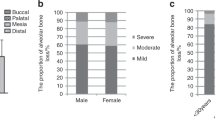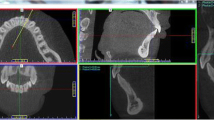Abstract
The object of this study was to evaluate the relationship between changes in the alveolar bone density around the teeth and the direction of tooth movement by using cone-beam computed tomography (CBCT). CBCT was used to measure the bone densities around six maxilla anterior teeth before and after 7 months of orthodontic treatment in eight patients. Each root was divided into three levels (cervical, intermediate, and apical) to determine whether the bone density change varied with the tooth level. Moreover, each level was divided into four regions (palatal, distal, mesial, and buccal sides). Three-dimensional computer models of the maxilla before and after orthodontic treatment were created to detect the direction of tooth movement. The percentage for all 144 samples [8 (patients) × 6 (teeth) × 3 (levels)] in which the side (palatal, distal, mesial, or buccal sides) of maximum bone density reduction (before and after orthodontic treatment) coincided with the direction of tooth movement was calculated; this was referred to as the “coincidence percentage”. The bone density around the teeth reduced by 24.3 ± 9.5%. The average coincidence percentage for the eight patients was 59.0%. The coincidence percentages for the eight patients were 62.5%, 62.5%, and 52.1% at the cervical, intermediate, and apical levels, respectively. The obtained results demonstrate that the direction of tooth movement is associated with the side of maximum bone density reduction, and that CBCT is a useful approach for evaluating bone density changes around teeth induced by orthodontic treatment.



Similar content being viewed by others
References
Noda K, Nakamura Y, Kogure K, Nomura Y (2009) Morphological changes in the rat periodontal ligament and its vascularity after experimental tooth movement using superelastic forces. Eur J Orthod 31:37–45
Garat JA, Gordillo ME, Ubios AM (2005) Bone response to different strength orthodontic forces in animals with periodontitis. J Periodontal Res 40:441–445
Melsen B (2001) Tissue reaction to orthodontic tooth movement—a new paradigm. Eur J Orthod 23:671–681
Cattaneo PM, Dalstra M, Melsen B (2005) The finite element method: a tool to study orthodontic tooth movement. J Dent Res 84:428–433
Verna C, Zaffe D, Siciliani G (1999) Histomorphometric study of bone reactions during orthodontic tooth movement in rats. Bone 24:371–379
Roberts WE, Roberts JA, Epker BN, Burr DB, Hartsfield JK (2006) Remodeling of mineralized tissues, part I: the frost legacy. Sem Orthod 12:216–237
Roberts WE, Epker BN, Burr DB, Hartsfield JK, Roberts JA (2006) Remodeling of mineralized tissues, part II: control and pathophysiology. Sem Orthod 12:238–253
Meikle MC (2006) The tissue, cellular, and molecular regulation of orthodontic tooth movement: 100 years after Carl Sandstedt. Eur J Orthod 28:221–240
Melsen B (1999) Biological reaction of alveolar bone to orthodontic tooth movement. Angle Orthod 69:151–158
Reitan K, Kvam E (1971) Comparative behavior of human and animal tissue during experimental tooth movement. Angle Orthod 41:1–14
Rygh P (1973) Ultrastructural changes in pressure zones of human periodontium incident to orthodontic tooth movement. Acta Odontol Scand 31:109–122
Jager A, Radlanski RJ, Taufall D, Klein C, Steinhofel N, Doler W (1990) Quantitative determination of alveolar bone density using digital image analysis of microradiographs. Anat Anz 170:171–179
Choel L, Duboeuf F, Bourgeois D, Briguet A, Lissac M (2003) Trabecular alveolar bone in the human mandible: a dual-energy X-ray absorptiometry study. Oral Surg Oral Med Oral Pathol Oral Radiol Endod 95:364–370
Al Haffar I, Padilla F, Nefussi R, Kolta S, Foucart JM, Laugier P (2006) Experimental evaluation of bone quality measuring speed of sound in cadaver mandibles. Oral Surg Oral Med Oral Pathol Oral Radiol Endod 102:782–791
Chen WP, Hsu JT, Chang CH (2003) Determination of Young’s modulus of cortical bone directly from computed tomography: a rabbit model. J Chin Inst Eng 22:121–128
Homolka P, Beer A, Birkfellner W, Nowotny R, Gahleitner A, Tschabitscher M, Bergmann H (2002) Bone mineral density measurement with dental quantitative CT prior to dental implant placement in cadaver mandibles: pilot study. Radiology 224:247–252
Aranyarachkul P, Caruso J, Gantes B, Schulz E, Riggs M, Dus I, Yamada JM, Crigger M (2005) Bone density assessments of dental implant sites: 2. Quantitative cone-beam computerized tomography. Int J Oral Maxillofac Implants 20:416–424
Bridges T, King G, Mohammed A (1988) The effect of age on tooth movement and mineral density in the alveolar tissues of the rat. Am J Orthod Dentofacial Orthop 93:245–250
Hsu JT, Chang HW, Huang HL, Yu JH, Li YF, Tu MG (2010) Bone density changes around teeth during orthodontic treatment. Clin Oral Investigations. doi:10.1007/s00784-010-0410-1
Toms SR, Eberhardt AW (2003) A nonlinear finite element analysis of the periodontal ligament under orthodontic tooth loading. Am J Orthod Dentofacial Orthop 123:657–665
Fuh LJ, Huang HL, Chen CS, Fu KL, Shen YW, Tu MG, Shen WC, Hsu JT (2010) Variations in bone density at dental implant sites in different regions of the jawbone. J Oral Rehabil 37:346–351
Norton MR, Gamble C (2001) Bone classification: an objective scale of bone density using the computerized tomography scan. Clin Oral Implants Res 12:79–84
Turkyilmaz I, Tozum TF, Tumer C (2007) Bone density assessments of oral implant sites using computerized tomography. J Oral Rehabil 34:267–272
Cann CE (1988) Quantitative CT for determination of bone mineral density: a review. Radiology 166:509–522
Mozzo P, Procacci C, Tacconi A, Martini PT, Andreis IA (1998) A new volumetric CT machine for dental imaging based on the cone-beam technique: preliminary results. Eur Radiol 8:1558–1564
Hua Y, Nackaerts O, Duyck J, Maes F, Jacobs R (2009) Bone quality assessment based on cone beam computed tomography imaging. Clin Oral Implants Res 20:767–771
Draenert FG, Coppenrath E, Herzog P, Muller S, Mueller-Lisse UG (2007) Beam hardening artefacts occur in dental implant scans with the NewTom cone beam CT but not with the dental 4-row multidetector CT. Dentomaxillofac Radiol 36:198–203
Katsumata A, Hirukawa A, Okumura S, Naitoh M, Fujishita M, Ariji E, Langlais RP (2007) Effects of image artifacts on gray-value density in limited-volume cone-beam computerized tomography. Oral Surg Oral Med Oral Pathol Oral Radiol Endod 104:829–836
Katsumata A, Hirukawa A, Noujeim M, Okumura S, Naitoh M, Fujishita M, Ariji E, Langlais RP (2006) Image artifact in dental cone-beam CT. Oral Surg Oral Med Oral Pathol Oral Radiol Endod 101:652–657
Lagravere MO, Carey J, Ben-Zvi M, Packota GV, Major PW (2008) Effect of object location on the density measurement and Hounsfield conversion in a NewTom 3G cone beam computed tomography unit. Dentomaxillofac Radiol 37:305–308
Naitoh M, Hirukawa A, Katsumata A, Ariji E (2009) Evaluation of voxel values in mandibular cancellous bone: relationship between cone-beam computed tomography and multislice helical computed tomography. Clin Oral Implants Res 20:503–506
Frost HM (1991) Some ABC’s of skeletal pathophysiology. 7. Tissue mechanisms controlling bone mass. Calcif Tissue Int 49:303–304
Epker BN, Frost HM (1965) Correlation of bone resorption and formation with the physical behavior of loaded bone. J Dent Res 44:33–41
Cardaropoli D, Gaveglio L (2007) The influence of orthodontic movement on periodontal tissues level. Sem Orthod 13:234–245
Roberts WE (1988) Bone tissue interface. J Dent Educ 52:804–809
Misch CE, Bidez MW, Sharawy M (2001) A bioengineered implant for a predetermined bone cellular response to loading forces. A literature review and case report. J Periodontol 72:1276–1286
Meghji S (1992) Bone remodelling. Br Dent J 172:235–242
Roberts WE, Helm FR, Marshall KJ, Gongloff RK (1989) Rigid endosseous implants for orthodontic and orthopedic anchorage. Angle Orthod 59:247–256
Dao V, Renjen R, Prasad HS, Rohrer MD, Maganzini AL, Kraut RA (2009) Cementum, pulp, periodontal ligament, and bone response after direct injury with orthodontic anchorage screws: a histomorphologic study in an animal model. J Oral Maxillofac Surg 67:2440–2445
van Oers RF, Ruimerman R, Tanck E, Hilbers PA, Huiskes R (2008) A unified theory for osteonal and hemi-osteonal remodeling. Bone 42:250–259
Acknowledgements
The authors would like to thank professors Che-Shoa Chang and Yuh-Yuan Shiau (School of Dentistry, College of Medicine, China Medical University) for their suggestions in this study. The authors wish to thank Li-Na Liao (Biostatistics Center and Department of Public Health, China Medical University) for her assistance of statistical analysis and Shang-Ran Huang (Department of Biomedical Imaging and Radiological Sciences, National Yang-Ming University) for his assistance of software analysis.
Conflict of interest
No authors of this study have any financial and personal relationships with other people or organizations, which could result in an inappropriate influence of this study.
Author information
Authors and Affiliations
Corresponding author
Additional information
Clinical relevance
CBCT can be used to detect changes in the alveolar bone density around teeth. In addition, the maximum reduction in bone density may be predicted based on the direction of tooth movement, which may represent important information for clinicians planning treatment procedures.
Rights and permissions
About this article
Cite this article
Chang, HW., Huang, HL., Yu, JH. et al. Effects of orthodontic tooth movement on alveolar bone density. Clin Oral Invest 16, 679–688 (2012). https://doi.org/10.1007/s00784-011-0552-9
Received:
Accepted:
Published:
Issue Date:
DOI: https://doi.org/10.1007/s00784-011-0552-9




